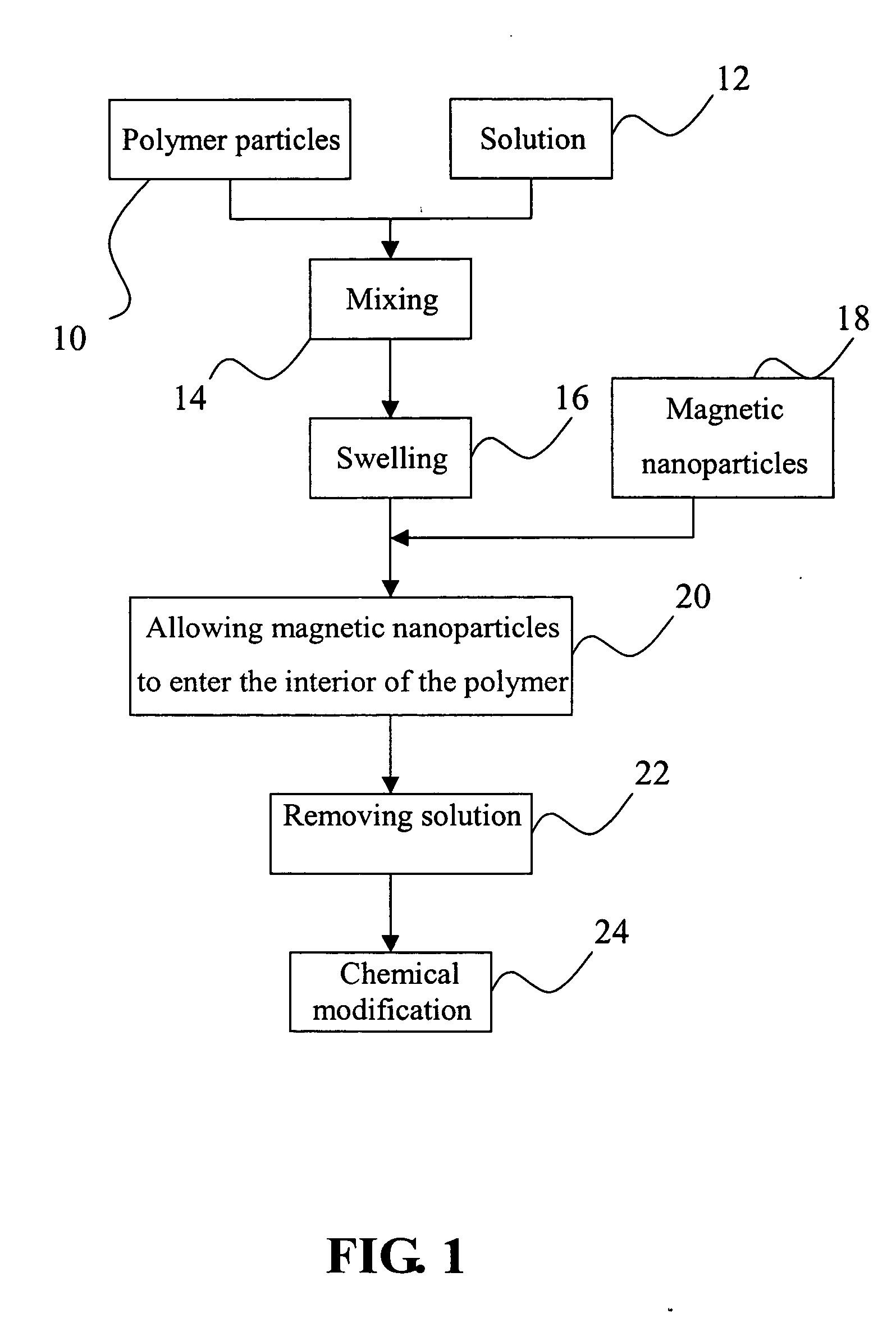Magnetic polymer microbeads and method for preparing the same
a polymer microbead and polymer technology, applied in the field can solve the problems of method limitation, irregular shape and size inability to control particle shapes and sizes of magnetic polymer microbeads, etc., to achieve high magnetization, high economic value, and high magnetization
- Summary
- Abstract
- Description
- Claims
- Application Information
AI Technical Summary
Benefits of technology
Problems solved by technology
Method used
Image
Examples
example 1
[0037] 1 g of polystyrene particles (prepared by dispersion polymerization), 20 ml of N-methyl-2-pyrrolidone (the value of the polar parameter is 6.0(cal / cm3)1 / 2, and the value of the hydrogen bonding parameter is 3.5(cal / cm3)1 / 2), 120 ml of deionized water, and 0.1 g of sodium dodecyl sulfate (dispersing agents) are added to an Erlenmeyer flask under stirring, and then is left soaking for 15 hours at room temperature.
[0038] Moreover, the magnetic nanoparticles are prepared by coprecipitation method. The iron(II) and the iron(III) ions in molar ratio of 1:2 are mixed in an Erlenmeyer flask under stirring at 300 rpm, and 1 M NaOH solution is used to adjust the pH of the mixture to 12, and then the mixture is allowed to react at 60° C. for 1 hour, cooled in an ice bath, and centrifuged at 3,000 rpm (˜2,500×g) to collect the black precipitate. Then, the black precipitate is immersed in 1N HCl solution for 1.5 hours. Finally, the precipitate is collected by centrifuging. The precipitat...
example 2
[0042] Following the same procedure as Example 1, four separate sets of polystyrene solutions are prepared. Each set of polystyrene solutions is prepared as following: 0.1 g of polystyrene particles (prepared by dispersion polymerization), 20 ml of N-methyl-2-pyrrolidone, and 15 ml of deionized water are added to an Erlenmeyer flask under stirring, and then is left soaking for 24 hours at room temperature.
[0043] Subsequently, 2.5 ml of 24 mg / ml Fe3O4 magnetic nanoparticle solution prepared from Example 1 is added to each of the three polystyrene solutions prepared above with stirring (at 140 rpm) for 24, 48, 72, or 120 hours, respectively (4 sets) in order to allow the magnetic nanoparticles to enter the interior of the polystyrene particles. Afterwards, the polystyrene particles are separated from the solution by centrifuging, washed six times with methanol and three times with deionized water, and dried by vacuum drying at room temperature for 1-2 days to obtain the magnetic poly...
example 3
[0044] 1 g of the magnetic polymer microbeads prepared from Example 1 are added to a mixed solution of 100 ml distilled water and 50 ml acetonitrile, fully dispersed by sonication. Then, the resulting reaction mixture is added to 1 ml of Disperbyk®-166 solution (from BYK), and then sonicated and stirred for 1 hour.
[0045] After the completion of the reaction, the mixture is centrifuged, and the supematant is discarded. The precipitates are washed 2-3 times using deionized water, and dried by vacuum drying at room temperature for 24 hours to obtain the magnetic polymer microbeads with about 0.1 mmol / g of aldehyde groups on the surface.
PUM
| Property | Measurement | Unit |
|---|---|---|
| Pressure | aaaaa | aaaaa |
| Particle diameter | aaaaa | aaaaa |
| Particle diameter | aaaaa | aaaaa |
Abstract
Description
Claims
Application Information
 Login to View More
Login to View More - R&D
- Intellectual Property
- Life Sciences
- Materials
- Tech Scout
- Unparalleled Data Quality
- Higher Quality Content
- 60% Fewer Hallucinations
Browse by: Latest US Patents, China's latest patents, Technical Efficacy Thesaurus, Application Domain, Technology Topic, Popular Technical Reports.
© 2025 PatSnap. All rights reserved.Legal|Privacy policy|Modern Slavery Act Transparency Statement|Sitemap|About US| Contact US: help@patsnap.com



